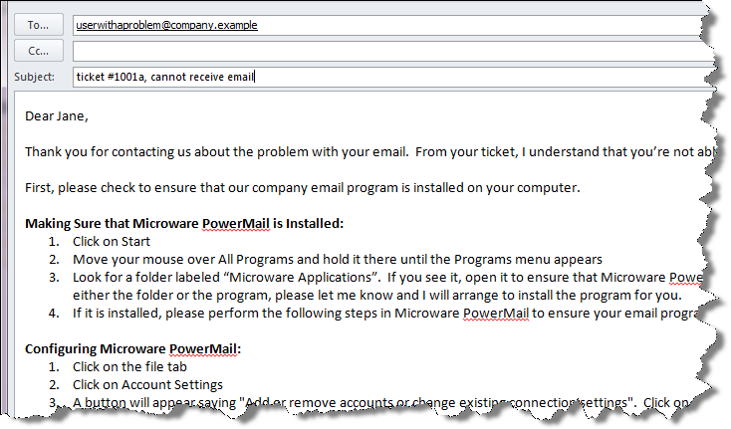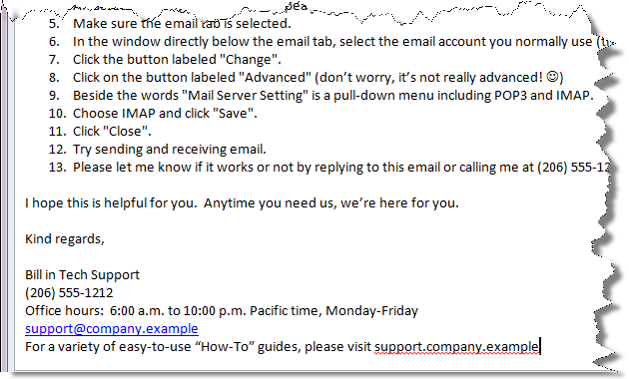Podcast: Play in new window | Download
Subscribe Now Apple Podcasts | RSS
Email is often the most commonly used form of communication for support professionals. Email is a one-dimensional form of communication which, although efficient, fails to account for human emotions as a vital component of communication. (Other forms of written communication including texting, instant messaging, and even old-fashioned paper letter writing suffer from the same limitation.)
In order for your customer or user to know you care and, frankly, to avoid wasting valuable company and personal time, you must follow several important rules when communicating via email.
- Use a descriptive and specific subject line that will help you and the user identify this particular email conversation in the future. Many support ticketing systems automatically add a ticket number. If yours doesn’t, consider adding a ticket number manually.
- Personalize your response by including the user’s name.
- Re-read the sender’s original email to ensure that you’re answering all of his or her questions and haven’t inadvertently overlooked any of the issues in the email. (Have you ever experienced the frustration of receiving only a partial response to an inquiry and having to send another email requesting answers to questions that were ignored from your first email?)
- Never assume that the customer or user has a particular level of knowledge. It is much better to be too thorough than to omit necessary steps because you assume the person receiving your email already knows something.
- Anticipate related issues that the user or customer might have and include links to support pages or, if necessary, steps for the recipient to follow if she encounters any related issues.
- Bullet-point your response to make it easier to read. Long paragraphs are difficult to read. It’s easy to miss interior points buried in lengthy blocks of text.
- If your response includes step-by-step instructions, be sure to number them. If you’re creating such instructions from scratch, be sure to test them to ensure you haven’t omitted any steps or made false assumptions about how the steps should work. (As a person who has written a ton of technical documentation, I’m speaking from personal experience on this!)
- Show professionalism by using proper grammar and avoiding the use of texting shortcuts (they’re fine for personal use, but have no place in business)
- Additionally, show professionalism by proofreading for meaning, spelling, grammar, and mechanical errors such as repeated keystrokes or incorrect spelling corrections (just get in the habit of re-reading every email completely before hitting the send button).
- Use emoticons to express or to clarify emotions (but be careful about their overuse). Also be sensitive as to who will be reading your email. You probably wouldn’t, for example, put a smiley face in an email to the CEO or other C-level executives of your company!
- Ensure your contact information is included in every email. Automated signature features in most email programs make this easy. Include your name, phone number, email address, office hours, and appropriate links such as your company or department website, support pages, and any work-related social networking sites such as LinkedIn.
Now, let’s take a look at some bad and good email examples.
Notice in this example how the support person seems to take a cavalier attitude toward the user and her problem. He displays unprofessionalism by using abbreviations, poor grammar (spelling “your” when he means “you’re”), assuming she knows how to make the change to IMAP, and not providing contact information.
In this example, however, the support staffer follows the above rules by:
- Providing a descriptive subject line
- Calling the user by name
- Repeating back his understanding of the problem
- Anticipating other problems (such as the program not being installed)
- Using headers to segment the problem resolution sections
- Numbering the steps
In this example, the bottom half of the previous example, he continues following the rules by:
- Using an emoticon to relieve any possible anxiety over the word “advanced”
- Providing contact information including office hours
- Providing a website with additional information.
Business runs on email. Sure, other forms of communication are in use all the time, but email is still the most common means of communicating, not just with customers, but also with colleagues in the workplace. The rules we’ve just gone over are really about treating each other with respect and empathy and not wasting each other’s time. When we follow the rules we help everyone, including ourselves, get the job done in the most efficient manner possible.
For More Ideas on How to Improve Communication and Customer Service Skills
Bring my IT customer service training seminar onsite to your location for your group, small or large. Click here for the course description and outline.
 Pick up a copy of my IT customer service book The Compassionate Geek: How Engineers, IT Pros, and Other Tech Specialists Can Master Human Relations Skills to Deliver Outstanding Customer Service, available through Amazon and other resellers.
Pick up a copy of my IT customer service book The Compassionate Geek: How Engineers, IT Pros, and Other Tech Specialists Can Master Human Relations Skills to Deliver Outstanding Customer Service, available through Amazon and other resellers.
Please Leave a Comment
If you find this post helpful or if you have additional thoughts, please leave a comment.






